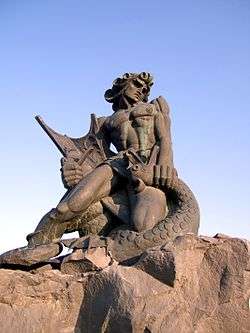Vahagn
Vahagn Vishapakagh (Vahagn the Dragon Reaper) or Vahakn (Armenian: Վահագն) was a god of fire, thunder, and war worshiped in ancient Armenia. Some time during ancient history, he formed a "triad" with Aramazd and Anahit. Vahagn was identified with the Greek deity Heracles. The priests of Vahévahian temple, who claimed Vahagn as their own ancestor, placed a statue of the Greek hero in their sanctuary. In the Armenian translation of the Bible, "Heracles, worshipped at Tyr" is renamed "Vahagn".

All the gods, according to the Euhemerist belief, had been living men; Vahagn likewise was introduced within the ranks of the Armenian kings, as a son of the Orontid Dynasty (or Yervanduni dynasty, 6th century B.C.), together with his brothers — Bab and Tiran.
Historian Khorenatsi's report of an ancient song gives a clue to his nature and origin:
- Ancient Armenian origin of Vahagn's birth song
- In travail were heaven and earth,
- In travail, too, the purple sea!
- The travail held in the sea the small red reed.
- Through the hollow of the stalk came forth smoke,
- Through the hollow of the stalk came forth flame,
- And out of the flame a youth ran!
- Fiery hair had he,
- Ay, too, he had flaming beard,
- And his eyes, they were as suns!
Other parts of the song, now lost, said that Vahagn fought and conquered dragons, hence his title Vishabakagh, "dragon reaper", where dragons in Armenian lore are identified as "Vishaps". He was invoked as a god of courage, later identified with Heracles.
The Vahagnian song was sung to the accompaniment of the lyre by the bards of Goghten (modern Akulis), long after the conversion of Armenia to Christianity.
The stalk or reed, key to the situation, is an important word in Indo-European mythology, in connection with fire in its three forms. Vahagn was linked to Verethragna, the hypostasis of victory in the texts of the Avesta; the name turned into Vahagn (the Avestan "th" becoming "h" in Arsacid Middle Persian), later on to take the form of Vahagn. See Վահագն for more on the origin of the name.
The name of the Armenian princely house of Vahevunis is believed to derive from Vahagn. The Vahevunis were ranked high in the Royal Register of Armenia, recorded by King Valarshak. In pre-Christian Armenia, the Vahevunis hereditarily possessed the temple town of Ashtishat on the left bank of the Aratzani river and most likely also held the post of the Sparapet, i.e., the Commander-in-Chief of the Royal Armenian Army.
Bibliography
- Petrosyan, Armen (2002). The Indo‑european and Ancient Near Eastern Sources of the Armenian Epic. Washington, D.C. : Institute for the Study of Man. ISBN 9780941694810.
- Petrosyan, Armen (2007). "State Pantheon of Greater Armenia: Earliest Sources". Aramazd : Armenian journal of Near Eastern studies. 2: 174–201. ISSN 1829-1376.
- Petrosyan, Armen (2018). "From Armenian Demonology the K'ajs". Journal of Indo-European Studies. 46: 206–218. ISSN 0092-2323.
- Ivanov, Vyacheslav (2011). "A Probable Structure of a Protoform of the Ancient Armenian Song of Vahagn" (PDF). Aramazd : Armenian Journal of Near Eastern Studies. 6: 7–23. ISSN 1829-1376.
- (in Russian) Ivanov, Vyacheslav (1983). "Выделение разных хронологических слоев в древнеармянском и проблема первоначальной структуры текста гимна Ва(х)агну". Patma-Banasirakan Handes. № 4: 22–43. ISSN 0135-0536.
External links and references
| Wikimedia Commons has media related to Vahagn. |
- A History of Armenia (Armenian Mythology) by Vahan M. Kurkjian. Published by the Armenian General Benevolent Union of America 1958/YR.